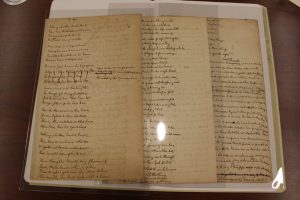Amongst the John S. Mayfield Papers housed at Georgetown University exists what may be the largest private collection of Algernon Swinburne’s works. This collection includes one hundred and one first edition copies of Atalanta in Calydon, a private journal kept by the author presumably during his years at Oxford, and assorted manuscripts. One of these manuscripts is the original autographed manuscript of the Swinburne’s disturbingly erotic poem entitled “The Leper.”
Swinburne’s poem was originally published in his 1866 collection of poetry entitled Poems and Ballads. Poems and Ballads caused one of the largest controversies in the history of English poetry because of the horrific and taboo topics explored in the text. “The Leper” portrays a grotesque romance between a woman ill with leprosy and the narrator, a servant of the woman’s who displays a fanatical obsession with her. The poem later showcases the love that the same man holds for the woman’s corpse.
The manuscript is incredibly fragile, so it is kept in a protective plastic covering. The paper is old and yellowed. Visually, Swinburne’s handwriting is well-spaced out towards the tops of the pages. However, the space between lines becomes much more tightened by the end of the page as he tries to finish an idea, thought, or verse without starting on a fresh page. This is also to utilize as much of the page as possible, as paper was an expensive commodity.
 The original manuscript of Algernon Charles Swinburne’s poem “The Leper.”
The original manuscript of Algernon Charles Swinburne’s poem “The Leper.”
Swinburne’s manuscript shows words, lines, and even whole verses that were originally written, then crossed out and replaced with different material. In some cases, changes are made in different colors of ink, showing that these changes were made later on in the process. On the bottom of one of the pages, the title and first lines are written upside-down, showing Swinburne may have started writing this poem and stopped. The words are smudged. Swinburne started fresh on a new page afterwards, yet wound up using this page later as well. The lines written at the bottom of this page are mostly the same as the finished product of the poem, with a small difference in the first line, and a larger one in the second where he originally stopped writing it. The first two lines in the published poem read, “Nothing is better, I well think,/Than love, the hidden well-water.” What was originally written is difficult to decipher, but it appears to say, “Nothing is better, I well know,/Than love, no [????] in.” While one word is very difficult to decipher, it is very clearly not “well-water,” the word that appears in his published poem.
 Smudged text located upside-down in Swinburne’s original manuscript of “The Leper.”
Smudged text located upside-down in Swinburne’s original manuscript of “The Leper.”
The presence of this revision in Swinburne’s draft are important because they showcase the writing process of this prominent Victorian poet. A larger, more interesting change occurs in this manuscript as well. On the first page, an entire verse is crossed out, with a new one – the one that wound up getting published – is written in beside it.

A verse from “The Leper” crossed out by Swinburne, with its replacement scrawled in beside the original text.
Part of the original text is obscured by his marks of excision. The clear parts read “Mere scorn God knows she had of me;/Her clerk’s hood hiding half my face,/Her lowered eyelids [????] [????]/The sad great love that let me base.” The revision reads “Mere scorn God knows she had of me;/A poor scribe, nowise great or fair,/Who plucked his clerk’s hood back to see/Her curled up lips & amorous hair.” The shift in these verses allows the reader to better understand the narrator of the poem in relation to the woman he loves – the revision shows that he is her scribe, someone beneath her who works for her. Without this revision, there is no clear relationship established between the two. It also gives Swinburne a chance to showcase the narrator’s infatuation with the woman by including a description of the woman’s lips and hair. Looking at the revision process is beneficial for a reader or a researcher to understand the evolution of a poem and to gain a greater appreciation and respect for the finished product.







One thought on ““The Leper:” A Rare Treasure at Georgetown University”
This collection is really a rare treasure. Thanks for the information.